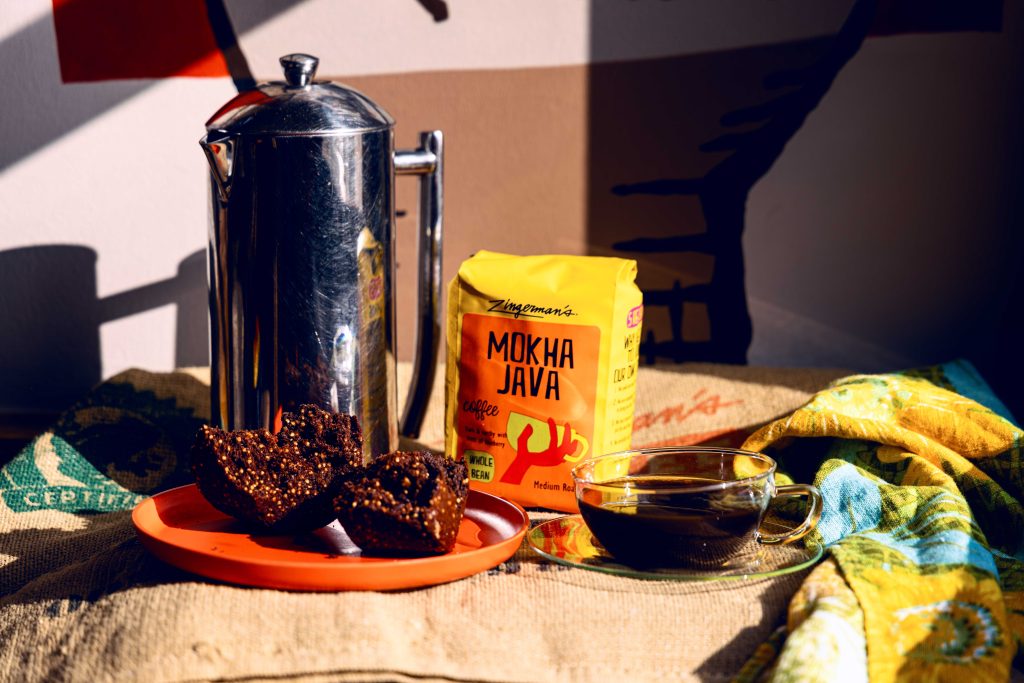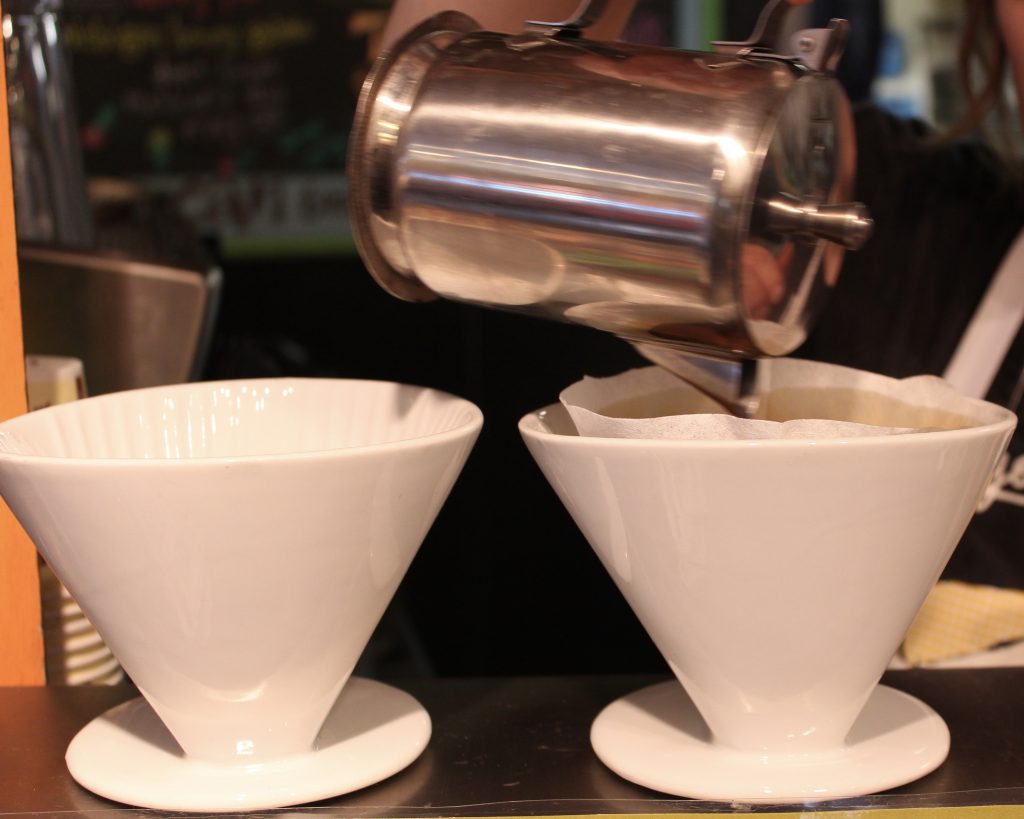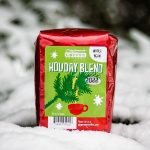And Why We Love the Coffee Company’s Beans
Just a few steps inside the Deli and you’ll quickly spot the vibrant yellow and orange packages of coffee from our friends and partners at Zingerman’s Coffee Company. Pop inside the Next Door Café and you’ll be welcomed with the enticing aroma of freshly brewed espresso. Whether you’re taking beans home or enjoying a latte on our patio, there was a long journey for that coffee to reach your hands, and a lot of care and craft by the Coffee Company to make it as good as it is.
Coffee 101
What Exactly is Coffee?
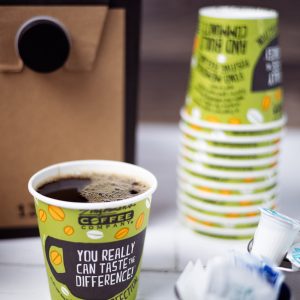
Coffee is a brewed beverage made from roasted coffee beans. Coffee beans come from flowering plants—bushes or small trees—native to tropical and southern Africa and tropical Asia. Coffee cultivation spread from East Africa to the Americas and Asia-Pacific via the major colonial trading powers of Europe. As you might suspect from their growing locales, most coffee species don’t tolerate freezing temperatures, but they do grow best at high elevations.
Of the over 120 species of coffee plants, two of them (Coffea arabica, commonly known as “Arabica,” and Coffea canephora, known as “Robusta”) account for almost all of the world’s coffee production. Within those species there are a number of different cultivars, like Typica, Catuai, and Bourbon (think about something we’re perhaps more familiar with, like apples—common cultivars would include Gala, Honeycrisp, and Braeburn).
From Seed to Cup
What we call a coffee bean is actually a seed of the coffee plant’s fruit, commonly called a coffee cherry. (Just like a coffee bean isn’t a bean, a coffee cherry isn’t a true cherry either, but admittedly, a “coffee epigynous berry” just doesn’t have the same ring to it). We dry the seeds, roast them, grind them, and then use them to brew coffee, but if that coffee seed wasn’t processed it could be planted and would grow into a coffee tree. That newly planted tree would take 3 or 4 years to bear fruit; coffee cherries turn deep red when ripe and ready to be harvested. Almost all coffee cherries are harvested by hand. It’s a labor-intensive process, but it’s also important from a quality perspective. Picking ripe fruit is important to the quality of the coffee beans, and doing it by hand allows pickers to only harvest the cherries that are at peak ripeness.
The harvested cherries then go to a processing plant, where the coffee bean is extracted from the cherry and dried. This can happen in a variety of ways; the Dry method, or Natural Process method, involves spreading out whole cherries and allowing them to dry. Natural coffees tend to have more body and rustic, earthy flavors. The Wet method, or Washed Process method, involves removing the pulp around the seeds, fermenting the seeds in water-filled tanks, rinsing the seeds, and then drying them. Washed coffees tend to preserve the vibrant notes and unique flavors of their origin. There are also processes that toe the line between wet and dry, like the Pulped Natural method, which involves removing the skin of the cherries and then letting them dry with almost all of the pulp still on the beans.
Hulling machinery separates the coffee bean from the dried fruit and parchment layers (for Natural) or just the parchment layer (for Washed). After that, beans are often polished, an optional step to remove a thin, papery layer. Next, beans are graded and sorted—often both by machine and by hand to ensure only the highest quality beans are exported—according to size and weight, and reviewed for any imperfections. Then the beans check to make sure their passports are up to date (no, not really) and are sent to their new homes where they will be roasted (more on that shortly).
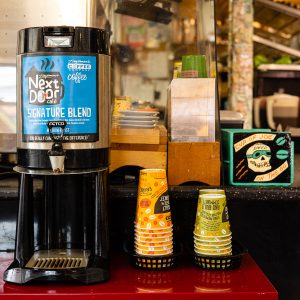 What Makes Zingerman’s Coffee Taste So Good
What Makes Zingerman’s Coffee Taste So Good
Our motto, “You really can taste the difference,” is true for every Zingerman’s business, and Zingerman’s Coffee Company is no exception. Here are four parts that all work together to bring you a really good cup of coffee. As the Coffee Company explains, “Each represents a phase that requires a lot of development, tasting, testing, re-tasting, and finally selection. They also represent a series of relationships from the farmer to you, the consumer. Each piece affects the other and all must work together.”
Sourcing
Zingerman’s Coffee Company focuses on selecting coffees from small producers, cooperatives, and single estates, looking for coffees that have distinctive regional characteristics that you can taste. With so many coffees available, their selection usually starts with one of the relationships they have with growers and importers. Managing partner Steve Mangigian has developed long-term relationships with coffee producers built on transparency and mutual commitment to quality. These relationships not only provide additional information about the coffee (like tracing particular coffee beans directly back to a specific plantation and learning how the crop was cultivated, harvested, and processed), but they also allow Steve and his team to better understand the needs of the individual producers and their communities. And, over time, they’re able to work with growers to cultivate beans tailored to specific flavor profiles.
Roasting
Roasting is the process of applying heat to coffee beans to develop flavor. There are obvious physical changes—the beans change in color from green to brown and expand in size—and some less-obvious changes too, like sugar and acid development.
It takes a lot of skill to know how to bring out the subtle characteristics of a coffee. Small differences in how beans are roasted can have a big impact on flavor, and any given bean can be roasted to accentuate different aspects, like more sweetness or more acidity. As the Coffee Company explains, “Determining what is ‘right’ reflects both the craft of the roaster as well as stylistic preference,” adding, “…we prefer sweet, clean, well-developed roasts over sharp, tart acidity. When we roast coffees that have a crisp acidity we like it to be balanced.”
Flavor
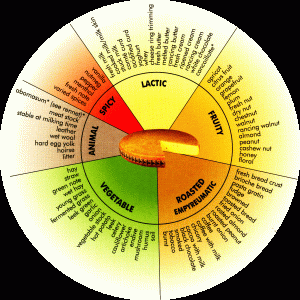
You need to start with good beans to make a good cup of coffee, so it’s likely no surprise that flavor is Zingerman’s Coffee Company’s highest priority when selecting a bean. A number of factors affect a coffee’s flavor development (climate, soil, rainfall, harvest technique) and flavor variation can even occur within different locations on a farm. The Coffee Company might try two dozen different samples of a given origin; cupping coffees from different farms, different processing methods, sizes, or grades.
A Cupping Interlude
What does “cupping coffees” mean? We sometimes talk about tasting food like an expert, and along those same lines, cupping is a formal procedure for tasting and evaluating coffee. It’s especially used by buyers and producers to assess the coffee’s flavor and quality. It might be used to evaluate a large number of samples for a purchasing decision, determine the roast level for a coffee, check the quality of a production batch, or compare the flavors produced by different brewing methods.
Cupping Process
- Smell dry coffee grounds to evaluate the fragrance.
- Add hot water (a crust will form) and evaluate the initial aroma.
- Allow coffee grounds and water to steep for a set amount of time.
- Break the crust with a spoon and evaluate the aroma again.
- Clean the top of the sample with a spoon, discarding floating grounds.
- Taste the coffee, slurping some air in with each sample and evaluating the acidity, flavor, body, and finish. (Take a peek at the SCA Coffee Taster’s Flavor Wheel for the wide range of flavors that can be present in coffee.)
Freshness
Starting with fresh beans is key for good coffee (old, musty beans aren’t going to magically get better over time!), as Zingerman’s Coffee Company says:
Coffee is a perishable good, so, fresh coffee equals good coffee. Coffee flavor peaks mere days after being roasted, and definitely should be consumed within a month of its roast date. Does the coffee you buy have a “best by” date as opposed to a “roasted on” date? Buyer beware! This can be totally arbitrary and result in purchasing a coffee that’s stale—lacking the aroma and depth of its formerly fresh self.
And not to worry, we’re paying attention to those roast dates for you. We get regular deliveries from the Coffee Company so we always have the freshest beans on our shelves (and we pull anything that gets too far past its roast date).
Notice how your beans are packaged. Coffee releases carbon dioxide after roasting, which is why Zingerman’s Coffee Company uses valve-sealed packaging—it lets that gas escape but doesn’t allow oxygen in. Coffee that’s in a vacuum-sealed package isn’t going to be as fresh; the roaster would have had to wait for the beans to stop releasing the CO2 before packaging them.
The Coffee Company’s Coffee Roster
All of this care and attention to detail from sourcing to roasting comes through in the flavor of their coffees. Below you’ll find more information about the coffees we regularly carry from Zingerman’s Coffee Company. Keep your eyes peeled when you’re shopping with us though, as we’ll often have seasonal offerings, like a monthly Roaster’s Pick or annual favorites like the Holiday Blend.
The Americas
Detroit Street Decaf (Dark Roast)
We wanted a decaffeinated coffee that would taste as good as an unprocessed coffee and that would make a great espresso, so the Coffee Company created this custom blend for us. Detroit Street Decaf is a full-bodied blend of Central American beans. As obvious as this might sound, to make a good decaf you have to start with good beans. (Often the lesser grade beans are sent for decaf.) This coffee uses the same grade, 100% SHG (Strictly High Grown), that the Coffee Company uses in their regular Guatemalan. Guatemalan coffees are perfectly balanced between acidity and sweetness, with a little floral in the nose, and good body.
Espresso Blend #1 (Medium Roast)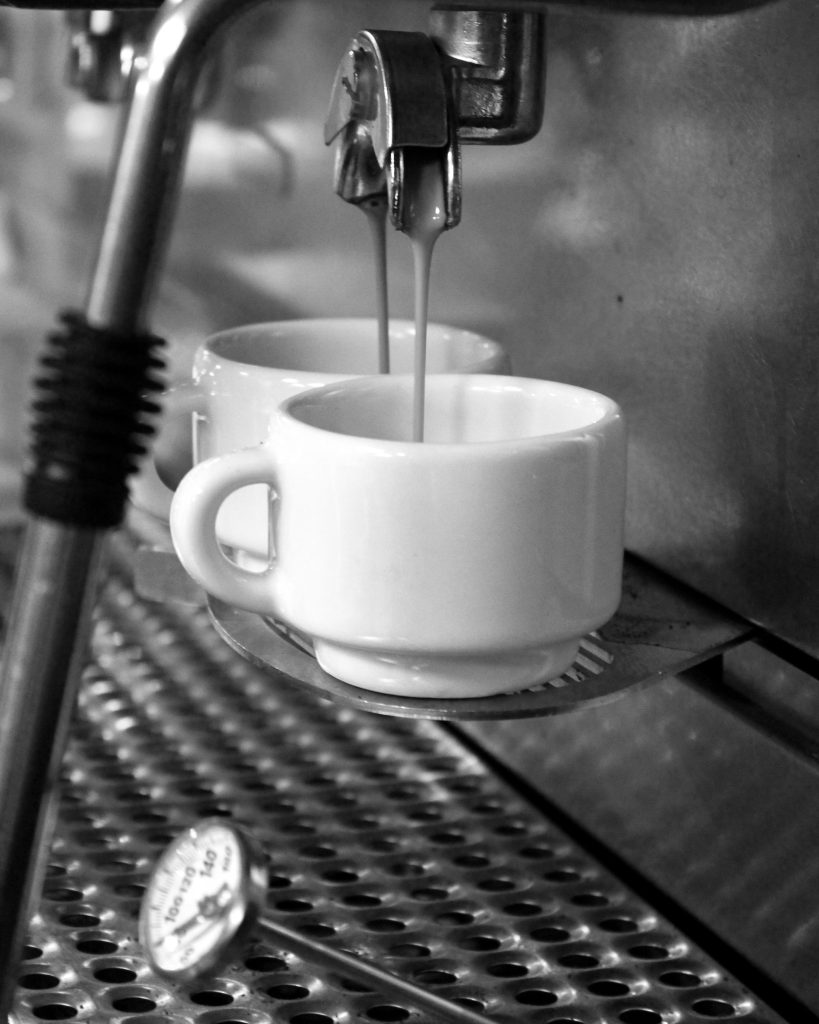
This coffee defies many conventions in the coffee world. It comes from a single farm, but is a sophisticated blend of different coffee plant varietals and processing methods. This “blend” is the result of the Coffee Company’s ongoing, decades-long relationship with Daterra Estate. Espresso Blend #1 is crafted to produce an espresso with a luxuriously thick crema that pours like warm honey. As drip coffee and as an Aeropress, the heavy body and sweet nuttiness comes through. Read more about it on our blog!
French Roast (Dark Roast)
French Roast refers to a dark roasting style that is surprisingly difficult to do well. Currently, the Coffee Company is using a Guatemalan bean from the farm Finca Santa Anita. This bean serves delicious as a French Roast, as it keeps its regional characteristics while still being able to take a lot of heat. This French Roast has a slight, pleasant acidity and notes of sweet, dark cocoa.
Africa
Ethiopia Guji (Light Roast)
Ethiopia is one of the most distinctive and fascinating coffee-growing regions of the world. There is a stunning amount of flavor variety found in coffees from Ethiopia. Various combinations of plant genetics, micro-climate, and processing methods produce cup profiles that range from citrusy, floral, bright, and elegant, to rustic, spicy, and deeply fruity.
This coffee from the Guji area is a fully washed lot from the Birbirsa Cooperative. Ethiopia Guiji is wonderfully balanced with notes of blueberry and milk chocolate, and a subtle, sweet citrus finish.
Asia & the Pacific
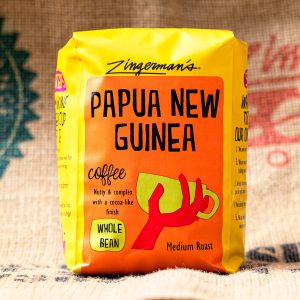
Papua New Guinea (Medium Roast)
About 85% of coffee from Papua New Guinea is grown by smallholder farmers whose plots are scattered over demanding and sometimes treacherous terrain. Most smallholders grow around 1,700 trees, but some grow as few as 20 along with a number of other crops. Sourcing a substantial volume of coffee from these smallholders in remote areas can be difficult. So the Coffee Company was thrilled to find this selection from the Apo and Angra Cooperatives.
From the region of Near Kainantu, Eastern Highlands Province, Papua New Guinea, this coffee is comprised of various varietals, and is grown at an altitude of 4,700-5,000 feet. The process for the beans is fully washed, and dried on raised beds. Papua New Guinea has a nutty and complex cocoa-like finish. Great as a pour over or Chemex brew.
Blends
Brazil Sweet Yellow (Light Roast)
Sweet Yellow are exceptional coffee beans from a very special grower in Minas Gerais, Brazil named Daterra. This high-plains estate is Rainforest Alliance certified, with half of the land considered a nature reserve. Fruit trees are still interspersed with the coffee trees in order to provide feed for native birds. The farm is active in its community and in promoting the rights of the workers on the coffee farms.
And the coffee? Brazil Sweet Yellow is made from a series of very special varietals (Yellow Bourbon, Catuai, and Caturra) that the folks at Daterra have spent years working on. Zingerman’s Roastmaster Steve Mangigian treats it gently, so the brewed cup is amazingly sweet, very nutty, and super smooth, almost buttery, with lots of happy high notes.
High Flyer (Medium Roast)
A sweet, clean brew, brightened with fruit flavors and a hint of cocoa. The aroma is slightly floral with the fruit flavors showing up in distinct aromas of blue and blackberry. A blend of Guatemalan and Ethiopian beans. High Flyer is a Zingerman’s exclusive—it’s only available at Zingerman’s Deli and Zingerman’s Mail Order!
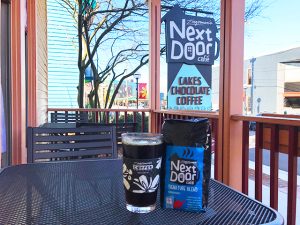 Next Door Café Signature Blend (Medium Roast)
Next Door Café Signature Blend (Medium Roast)
Zingerman’s Coffee Company created this signature blend just for us. It debuted in 2019, and as the name suggests, you can only find the Next Door Blend at the Next Door Café! This blend of small-lot beans was created for coffee lovers and aficionados everywhere and was designed to drink all day, every day. Sumatra Mandheling provides the backbone of the cup with a heavy, velvety body; cooperative-grown beans from Papua New Guinea impart natural sweetness and depth; and a micro-lot coffee from longtime Zingerman’s partners at Hacienda Miramonte in Costa Rica adds a bit of aromatic complexity. Next Door Blend unites rich flavors of dark chocolate caramel. Read more about it on our blog.
Mokha Java (Medium Roast)
This is a little bit of a “light and dark” blend. It combines the light roasted Ethiopian with some darker Indonesian coffees—Sumatra and Papua New Guinea. The fruitiness and acidity (berries and citrus) of the Ethiopian are a good compliment to the dark roasted Indonesians, which bring some thicker body, smoky bits, and also some fruit as they cool.
The name Mokha Java is a reference to two of the first coffee trading port cities (late 1500s). Mokha is on the Red Sea in Yemen and is no longer an active port. Yemen still produces coffee although the political climate is currently making it harder to obtain. Java, Indonesia was known for coffee as it was a Dutch colony. The Dutch were one of the first great trading powers.
Roadhouse Joe (Medium Roast)
In preparation for the opening of Zingerman’s Roadhouse in 2003, months of collaboration and tasting resulted in the creation of this signature coffee blend. It’s been a hit ever since. Designed to complement food, it emphasizes body and balance over sharpness and acidity. It finishes with a very slight nuttiness and is by far our most popular blend.
Technically, it’s a mix of Papua New Guinea, Costa Rican, Indian, and Brazilian Peaberry, each added for their contribution to body, balance, and nuttiness. Less technically—but more importantly—Roadhouse Joe is a sensible, smooth, crowd-pleasing coffee that’s guaranteed to satisfy anyone. Read more about it on our blog.
Zingerman’s Coffee Drinks at the Next Door Café
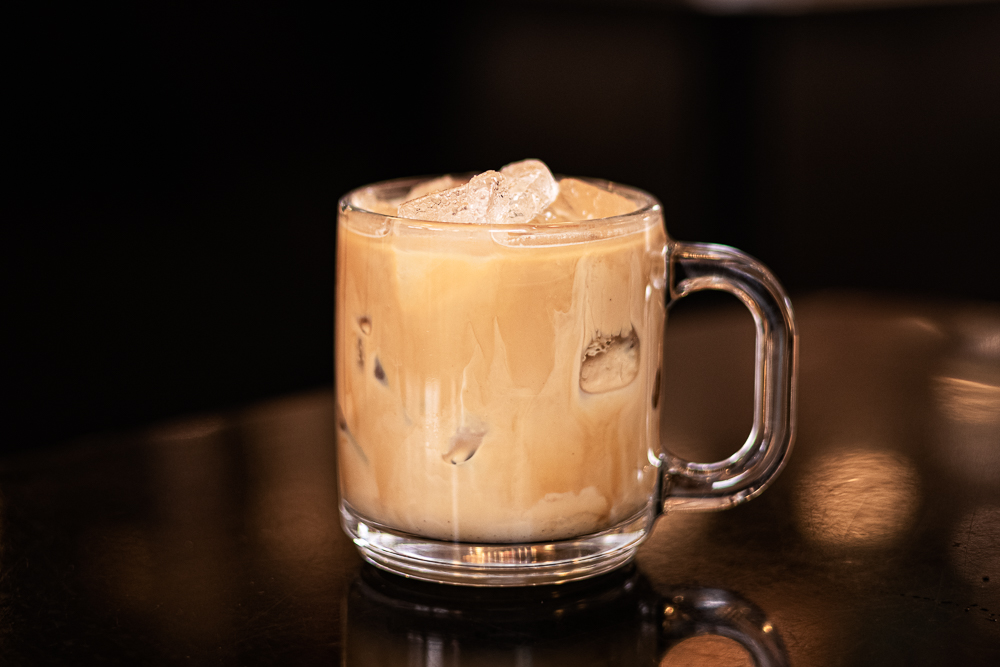
Like everything else we make, the quality of the ingredients that go into a latte or a cappuccino will have a huge impact on the flavor of the finished item. So all of the espresso drinks we make at the Next Door Café start with a pair of excellent ingredients:
- Espresso Blend #1—Sustainably-grown, Rainforest Alliance-certified beans from Daterra Estate in Brazil.
- Milk from Calder Dairy—One of the state’s only farmstead dairies, the Calder family still has its own herd of about 150 cattle. (And yes, in addition to whole, 2%, and skim milk, we also have oat milk and almond milk.)
Espresso is ground to a finer texture than drip coffee, which makes the flavor much more concentrated. Our espresso grinder in the Next Door is automatic, meaning it dispenses the same weight of grounds for every espresso shot. Beans for espresso are ground as needed—slotting a portafilter (literally a portable filter where the extraction magic happens) into its little resting spot at the bottom of the grinder will activate the machine and deposit the correct amount of grounds. The barista tamps down the grounds into an even, flat puck inside the portafilter, then hot water filters through the espresso grounds and into the awaiting cup below to create a silky shot of espresso with a beautiful blonde crema (a flavorful frothy layer topping the shot).
Even though part of the process is automated, depending on a barista’s previous experience it can take a few weeks, to really get a handle on the espresso bar. Especially because when it comes to steaming milk, a trained eye and a trained ear are crucial. Baristas learn what milk looks and sounds like when it’s at a proper temperature and consistency for a latte or a cappuccino.
For our drip coffee, we regularly check throughout the day to ensure there’s always a fresh pot for our guests. Those beans are run through a slightly more manual grinder; the beans are poured through the top, a knob is adjusted to the desired grind level, and a button is pressed to begin the grinding process. This is also what we use to grind any beans you buy!
How to Treat Your Coffee Right When Brewing at Home
If you’ve made it this far, it’s probably a fair assumption that a cup o’ joe (or two or three) is a valued part of your daily routine. If you’re making your own coffee at home, brewing is the final step to bringing out the best of those beans before you can take a sip. We like to think of the whole preparation process from storage to brewing to clean up as much a part of that daily ritual as drinking it is. As the Coffee Company says, “Our coffee is a labor of love from around the world, and its journey ends in your hands!”
Store Your Beans with Care
Thinking about how you received your beans (in an opaque package that isn’t letting oxygen in) is a good way to think about how you want to store them at home. Keep your coffee in a cool, dark spot, like a pantry or a cupboard, and ideally in an opaque, airtight container.
The freezer is not the best spot to store your beans. Thawing and refreezing can cause freezer burn, which impacts the coffee’s flavor. If you have a big surplus of coffee beans and freezing is really the only option, pre-portion it out into smaller bags. That way you’re only taking the coffee out of the freezer one time.
Consider Your Brewing Method
For the absolute freshest coffee, grind your beans right before preparing your coffee. If you’d rather not invest in a home grinder, we’ll happily grind your beans for you when you buy them, and we can calibrate the grind (fine, medium, or coarse) depending on how you’ll be brewing the coffee.
You only need three things to make coffee—ground coffee, water, and some form of a filter—but there are a number of different ways to actually go about brewing it! Which method you choose might depend on a variety of factors, like how much coffee you want to make, how much effort (or not) you want to put into your cup of coffee, what texture you’d like the finished coffee to have, and even the type of bean you’re using. These are four of the most common methods for brewing coffee at home:
- Drip Coffeemaker
- This method is all about convenience. If you’d like the easiest option possible, this is the one for you. Flip a switch, and stand by. Opt for a medium grind.
- French Press
- This is an immersion brew method, meaning the coffee beans are covered with water and steeped, then strained through a metal filter. This allows oils and small coffee particles to pass through, resulting in a full-bodied cup of coffee, making a French press an especially good choice if you always add milk or cream to your coffee (though it’s good black, too). Opt for a medium grind.
- Pour Over
- This is just what it sounds like, water is slowly poured over grounds to saturate them and extract the coffee flavors. Pour over is a great place to start to get into hand brewing. (Chemex would be a variation of this, Chemex paper filters are just heavier than other paper filters, so they retain more oils and solids.) Opt for a medium grind.
- AeroPress
- This unique single-cup brewing method uses a combination of immersion (like French press) and filtration (like pour over) techniques. After steeping, the coffee is forced through a filter by pressing a plunger through the tube. An AeroPress might be the method for you if you want to make great coffee anywhere you go. Opt for a fine grind.
Clean Your Equipment
Once you’ve enjoyed your coffee, you always wash the mug, but how about the coffee equipment? It’s one of those sneaky little cleaning tasks that can be easy to forget about. So if you can’t remember the last time you cleaned your coffee gear, it might be time to give them a little TLC. Over time, your equipment can get buildup from coffee oils and scale deposits from hard water, which affect how well it functions.
How to Get Your Coffee Fix
If all of this talk of coffee has you craving a cup:
- Stop by the Next Door Café and let us make you a drink or order online and we’ll have it ready and waiting for you (Psst—you might want to pair it with a pastry!).
- Order Zingerman’s Coffee (whole bean or freshly ground to your liking) on our online store for pickup or Ann Arbor Delivery.
- Serve coffee to a crowd with the help of Catering & Events.
- Call us at 734.926.4005 to place your order.

